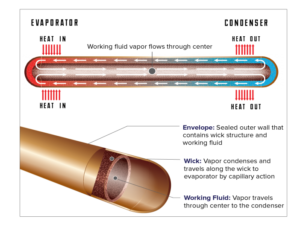COMMON HEAT PIPE COMBINATIONS
ACT’s most popular video on YouTube happens to be one of the first videos we posted (way back in 2012) titled “Heat Pipe Basics and Demonstration.” In may not be the most visually appealing, but what it does do is provide a high level overview of heat pipe operation and opens the door for viewers to want to know more.
One question we have received several times after someone has watched this video: What is a typical working fluid, and what material is used as wick material?

We often get asked what envelopes and wicks are made of, and what can be used for working fluids. There are a significant number of materials that can be used for each, but the important requirement is that the fluid and materials must be compatible.
Heat pipes have been built to operate at a variety of temperatures, ranging from -271°C with helium as the working fluid and 2000°C or higher with lithium as silver as the working fluid.
First, determine the operating temperature range for your heat pipe. For a heat pipe to operate, it must be at saturated conditions, where the heat pipe contains both liquid and vapor. Because of this, fluids can only operate (theoretically) between the triple (freezing) point and the critical point, where vapor and liquid phases have the same properties.
With this said, there are some common combinations you will find. While the following list is not exhaustive, it provides some of the most common heat pipe / envelope / wick combinations.
Again, this is only a few of the most common heat pipe combinations. To learn more about various heat pipe working fluids and wick materials, check out the Heat Pipe Learning Center.
